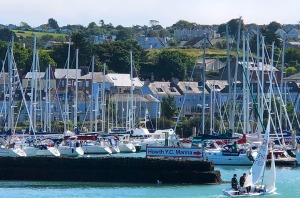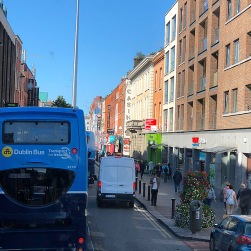In honor of St. Patrick’s Day, I’m posting the first of my Ireland blog series. My husband Gunter and I toured Ireland in September 2018 as part of a mission to reconnect with European cruisers with whom we had sailed during our world circumnavigation. We had the good fortune of being hosted by Patrick Murphy, a native Irishman who loves his country, and his partner, Geraldine. Upon arriving, we checked into a hotel in Howth overlooking the Irish sea with a view of Ireland’s Eye, a small uninhabited island off the coast. We were close to Howth Harbour, where Pat still docks his yacht Aldaberan after sailing it around the world. During the week we spent in Ireland, Pat took us to yacht clubs, maritime museums, and shipbuilding exhibits, including the Titanic Exhibit in Belfast. These are covered in another blog called Cruising Camaraderie.

Howth Marina
The Howth Castle. This was the first of many castles we saw in Ireland, including the imposing Dublin Castle. It’s a hidden gem, the private residence of the Galsford-St. Lawrence family and still occupied by the descendants. The view from the top of the peninsula of Howth Head, northeast of Dublin, provides a stunning view of the harbour and village below.

Howth Castle
Sightseeing in Dublin. During our first full day in Ireland, we took a city bus directly to City Centre and then bought tickets for a city bus tour, the best way to get an overview of this vibrant city. This gave us a nice overview of the city, landmarks such as the National Museum of Ireland, the National Gallery, Dublin Castle, the Temple Bar district, Christ Church Cathedral, St. Patrick’s Cathedral, Guinness Storehouse, and Kilmainham Gaol and Hospital. After that preview, it was time to walk the city.
The Story of the General Post Office. The main avenue in Dublin is O’Connell Street, 500 feet wide, with monuments to Irish history in the middle. All the way, we couldn’t miss the Millennium Spire, a 395-foot high stainless-steel monument which replaced the 19th century Nelson’s Pillar blown up by anti-British rebels in 1966. O’Connell street’s most famous landmark is the General Post Office, which Pat described to us at length. “See these bullet holes,” he said. “These were made during the Easter rising of 1916, when a group of Irish nationalists proclaimed the establishment of the Irish Republic. They and 1600 followers staged a rebellion against the British government in Ireland here. They used this GPO as their headquarters.”
We talked with a “soldier” posing as a rebel outside the Post Office. Then we went inside to view commemorative plaques and statues about the Rising. We learned that the rebels, along with some 1600 followers, seized buildings in that area and clashed with British troops. Within a week, the British quelled the rebellion and left 2000 dead or injured. The leaders of the rebellion soon were executed. Initially, there was little support from the Irish people; however, public opinion later shifted, and the executed leaders were hailed as martyrs. In 1921, a treaty was signed that established the Irish Free State, which eventually became the modern-day Republic of Ireland.
South of the Liffey. Dublin takes its name from the southwest of the city. Apparently in prehistoric times there was a dark pool (Dubh Linn) at the confluence of the River Liffey and what was once the River Poddle. During the 18th century, the Temple Bar became a center for merchants and craftsmen. The southeast was undeveloped until the founding of Trinity College in 1592. St. Stephens Green was enclosed in the 1660s but was private until 1877. Today the south is the hub of the fashionable scene, with designer stores and fine restaurants.

Liffey River
Trinity College. Visiting Trinity College, Ireland’s most famous educational institution, is a must. Since its foundation in the 16th century, it has produced many impressive alumni—including Jonathan Swift, Oliver Goldsmith, Oscar Wilde, Bram Stoker, and Samuel Beckett. Entering the cobbled square surrounded by green lawns, 18th and 19th century buildings, and a 100-foot bell tower might have been like walking into a bucolic time-warp—except for the hundreds of students, posters, and booths filling the space. A student orientation event was in process and the lines were so long that we couldn’t get into the library. Too bad. I would have liked to view the 200-foot long room, with two tiers of oak bookcases holding more than 200,000 books. The Old Library is home to one of Ireland’s greatest treasures: the 9th century, lavishly illustrated Book of Kells, containing the four gospels of the New Testament in Latin. We exited the campus at the front arch, in between statues of Edmund Burke and Oliver Goldsmith.
St. Stephen’s Green. This 22-acre park with two miles of walkways is a great way to take a bucolic break within the city limits. It still has the original Victorian layout. Bedding plants are changed out during the year. We strolled past sculptures and around a serene, man-made lake. Lunchtime concerts are performed throughout the summer.

Serene lake at St. Stephen’s Green
Back at City Centre, we enjoyed a magnificent lunch at Bewleys Grafton Street Café. But the food was only a small part of our fun there. We were seated in the main dining room on the ground floor. Although the café was jam-packed tightly with tables, we didn’t mind. The entire 1920s café was decorated with art nouveau and stained-glass windows designed by celebrated Irish artist Harry Clarke. After lunch, Geraldine and I walked to the second floor to find a charming art deco café, then went up another flight of stairs to discover a small theatre at the top. Do stop here—even if it’s just for a cup of tea.
After lunch, we watched the street entertainment for a while. This cyclist/knife juggler took our breath away. He deserved his tips!
On the way back, Patrick stopped to show us a tree carved with every species of sea-life imaginable.

Magnificent Carved Tree
Finally, enjoy “the craic.” Despite the sights, Dublin would be nothing without the warmth and conviviality of the Irish people. Craic (pronounced crack) is term for news, gossip, fun, or entertainment. It’s the perfect word for describing the bubbling, sparky mix of fun and banter that is Dublin.
About the Author: Lois and Günter Hofmann lived their dream by having a 43-foot ocean-going catamaran built for them in the south of France and sailing around the world. Learn more about their travel adventures by reading Lois’s nautical adventure trilogy.





